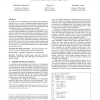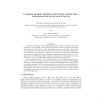29 search results - page 4 / 6 » Desynchronizing Synchronous Programs by Modes |
PPOPP
2006
ACM
14 years 1 months ago
2006
ACM
We present two new nonblocking and contention-free implementations of synchronous queues, concurrent transfer channels in which producers wait for consumers just as consumers wait...
HLPPP
1991
13 years 11 months ago
1991
Swarm is a computational model which extends the UNITY model in three important ways: (1) UNITY’s fixed set of variables is replaced by an unbounded set of tuples which are add...
PPL
2008
13 years 7 months ago
2008
Execution of programs with data parallel language constructs is either based on the fork/join or on the SPMD model. Whereas the former executes a program sequentially and confines...
ECRTS
2000
IEEE
13 years 12 months ago
2000
IEEE
Real-time Systems, in particular regulation systems, are often specified using the notion of running modes. On the other hand, the family of synchronous languages [1] has been ve...
JMLC
2000
Springer
13 years 11 months ago
2000
Springer
Most object-oriented languages offer a limited number of invocation semantics. At best, they define a default mode of synchronous invocation, plus some keywords to express addition...


